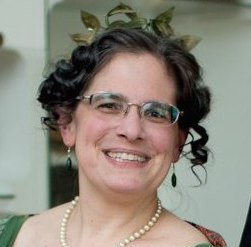This month is going to feature some mental whiplash: two classes of fantasy-Regency (meaning, totally bogus from a historical perspective) Bridgerton dance classes, then haring off to England to immerse myself in serious academic dance history at Oxford University! Plus sneaking in some research time and exciting extra excursions while I'm in the neighborhood…
Author: Susan de Guardiola
-
March 2025 Gig Calendar
March is weird. Two weeks of absolutely nothing, then eight days of gigs in two weeks. Whee! Technically, that is four teaching days (including a three-day weekend), one evening of DJing, one morning and one evening of calling, and an academic conference, with trips to Boston and New York as well as two other parts of Connecticut. Plus at least one day of library research. The time periods jump from the Renaissance to the early 19th century to the present; it's almost as insane a mix as February. I love it, but I wish things could be spread out a little bit more evenly…
-
February 2025 Gig Calendar
Busy, busy: that's February for me. Two weekends in California followed by an eclectic set of sessions at The Flurry Festival, then a relatively light last weekend with another Dances of Bridgerton class!
-
January 2025 Gig Calendar
Happy new year! After completely failing to have a restful holiday break in December, I am more-or-less doing that in January before everything gets crrrrrrazy in February.
-
December 2024 Gig Calendar
December is usually a quiet month for me, but this year it's hopping! I'll be off to New Jersey twice, Boston once, and then at the end of the month Florida for an entire weekend of dance and fun that is FREE for attendees!
-
November 2024 Gig Calendar
My November has two main events: a weekend of waltzing in which I travel up and down I-91 from Connecticut to Massachusetts and back, and the big Remembrance Day Balls in Gettysburg. In between, another Bridgerton class. Afterward, rest and catching up on life!
-
October 2024 Gig Calendar
I’m going to be bouncing around geographically in October, both physically and virtually: first, a quick trip to Boston to do research and DJ for Bluesy Tuesy and a virtual appearance at an Oregon event focused around the composer Joseph Bologne, Chevalier de Saint-Georges. Then I’m off to Scotland once more (wasn’t I just there?) for the European Association for Dance History’s annual conference, complete with a workshop on the double quadrille by the not-nearly-notable-enough Mrs. Nicholas Henderson. The workshop is free, if anyone happens to be in Scotland!
-
September 2024 Gig Calendar
This month is going to mostly be personal time for me: a family visit and an Actual Vacationtm. I’ll be squeezing a few days of library research (three different sites) in around these, but mostly I’ll be quietly traveling around doing non-dance things.
Then, at the very end of the month, something new: Bridgerton dance! This is specifically dance from the television series which — news flash! — is not intended to be historically accurate. I regard the show as speculative fiction (alternate history) and the dances as fantastical, not historical. You can read some of my thoughts about this here. I taught a couple of these dances in Scotland last month, but this will be the first time teaching them in the USA.
-
Highland Mazourka
Let’s get the important part out of the way first:
The Highland Mazourka is not a mazurka.
It is, however, a delightful example of the nineteenth-century tendency to transpose dances from one time signature to another. In this case, typical polka mazurka sequences have been transposed from 3/4 time to 4/4 time with a bit of extra hopping added to fill out the music, which should be of the Scottish strathspey style. The polka mazurka itself consisted partly of polka (2/4) steps transposed to 3/4 time. Confused by all these shifting time signatures? Fear not; all will be made clear below!
-
August 2024 Gig Calendar
I'll be starting out August with a couple of weeks in Scotland. The first weekend, I'll be teaching a dance workshop and leading a tea dance in Edinburgh, both with a general theme of Scottish dances influenced by or connected to those of Continental Europe and Continental dances that appeared in Scottish sources. The second weekend, I'll be having a very eclectic time at the World Science Fiction Convention in Glasgow, which for me will include giving a popularly-oriented paper, leading a masquerade ball for which I've been reconstructing some truly terrifying dances from video, and DJ'ing a blues dance. In between: library time and perhaps a bit of tourism!
Later in the month I'm looking forward to a reunion with a group of my most dedicated online students from pandemic times.

